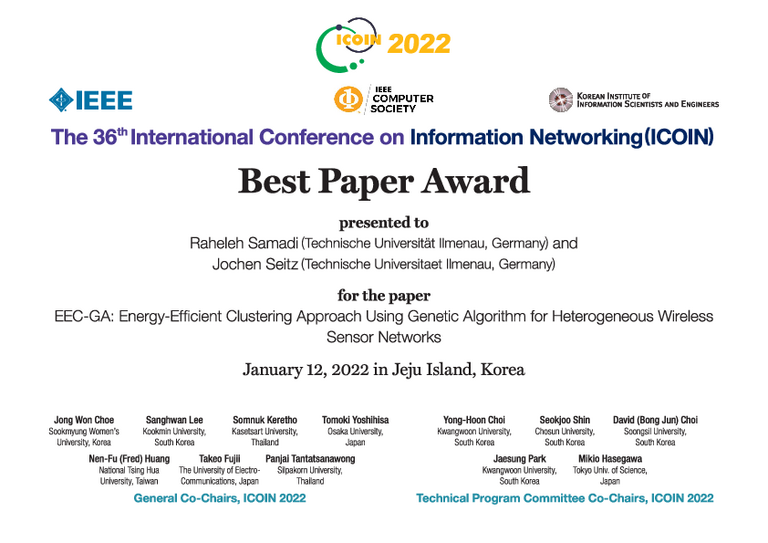At the 36th International Conference on Information Networking (ICOIN), TU Ilmenau doctoral student M. Sc. Raheleh Samadi has been awarded the Best Paper Award.

Raheleh Samadi received the award for her publication "EEC-GA: Energy-Efficient Clustering Approach Using Genetic Algorithm for Heterogeneous Wireless Sensor Networks," which was produced at the Group of Communication Networks under the direction of Prof. Dr. Jochen Seitz. The conference, hosted by the Institute of Electrical and Electronics Engineers (IEEE), was held virtually from January 12-15, 2022.
A native of Iran, she studied at Islamic Azad University in Computer Networks and then worked as a lecturer and editor-in-chief of a technical journal. Since spring 2021, she has been conducting highly successful research in the field of the Internet of Things as part of her doctoral studies at TU Ilmenau. The award-winning work focuses on energy-efficient communication in wireless sensor networks, which are the basis for the so-called Internet of Things. Here, a wide variety of devices and equipment exchange information with each other to make life easier and more convenient for users. For example, sensors can alert a user that a window is still open in his or her "smart home" when he or she wants to leave the house, or a user who wants to travel is alerted to a delayed streetcar so that she would miss her train, and at the same time a cab is summoned so that she can still catch her train.
Such sensor networks often consist of individual, battery-powered sensor nodes whose communication is very energy-intensive. Raheleh Samadi succeeded in developing a method for forming a so-called cluster from closely spaced sensors. Communication with nodes in another cluster is then handled by a dedicated sensor, the cluster head. The formation of the cluster and the choice of cluster head is crucial to how much energy can be saved. Here, the Ilmenau scientist relied on a genetic algorithm in which various cluster configurations are generated according to the biological model of evolution and assessed on the basis of a fitness analysis. Only the "fit" configurations are further modified by mutation and recombination, i.e. "bred". In this way, a cluster structure suitable for the current distribution of sensors is finally found, which optimizes the energy required for communication. The expert jury was impressed by the results achieved by the Ilmenau doctoral student in both theoretical research and the practical evidence provided. In simulations, Raheleh Samadi had proven that her approach offers significant advantages for energy savings in wireless sensor networks compared to other published methods.

